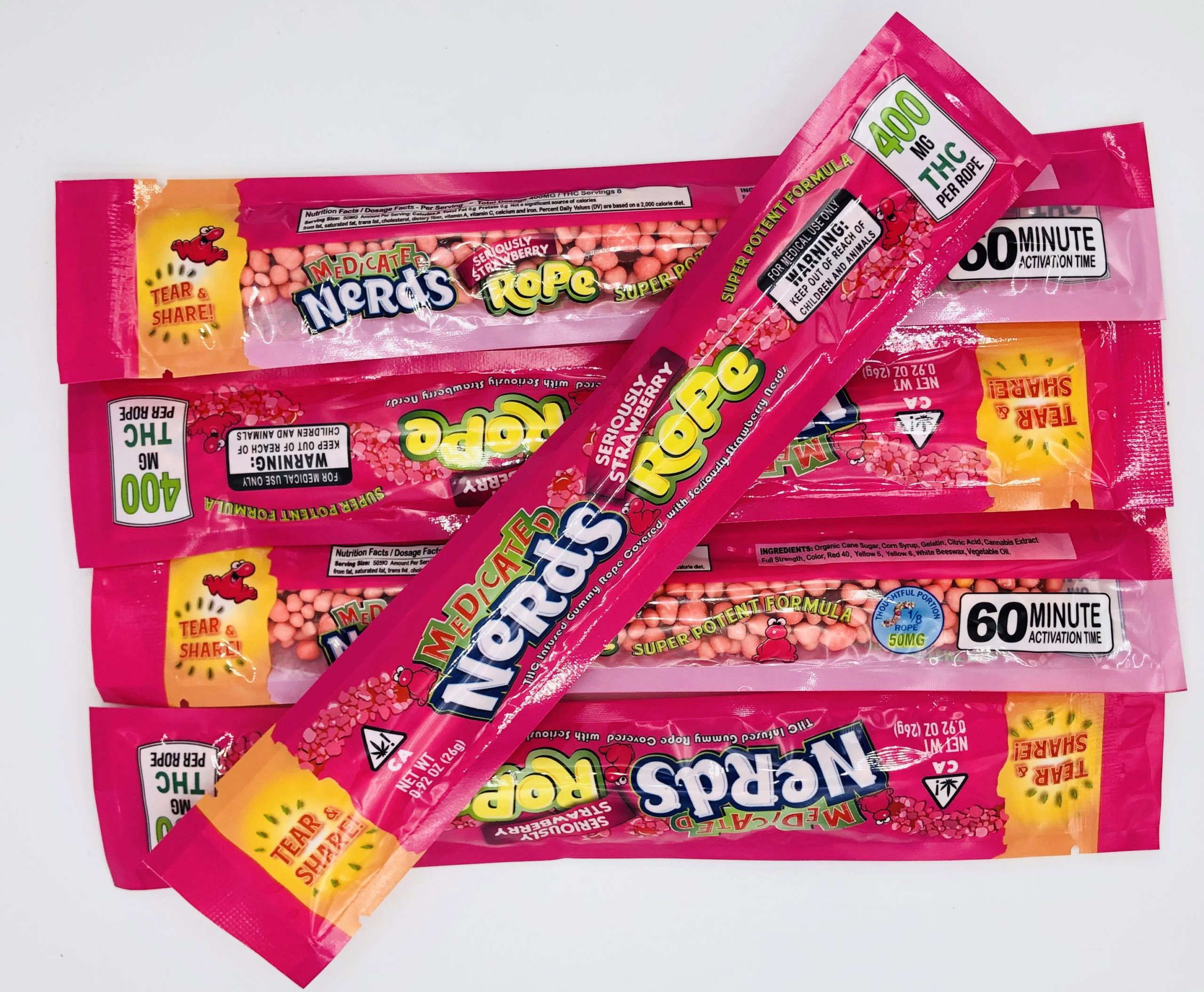
ROY, Utah — Two youngsters, 5 and 11, were hospitalized April 3, after eating candy their grandmother had picked up that morning from the food pantry ministry of First Baptist Church (FBC) of Roy, Utah, 32 miles north of Salt Lake City.
 The package of candy that was labeled “Nerds Rope” was infused with 400 mg of THC, the medical component of marijuana. That dosage is at least 40 times the amount of THC a person might use to manage rheumatoid arthritis pain, the church’s lead deacon, Mark Hughes, said.
The package of candy that was labeled “Nerds Rope” was infused with 400 mg of THC, the medical component of marijuana. That dosage is at least 40 times the amount of THC a person might use to manage rheumatoid arthritis pain, the church’s lead deacon, Mark Hughes, said.
“An adult might take 5 to 10 milligrams for pain,” Hughes said. “It was definitely enough to make kids very sick.”
Out of 63 people served within the food pantry’s first hour April 3, three other children are known to have become ill after eating some of the candy, though not sick enough to be hospitalized. Both hospitalized youngsters were home by the following Monday, April 6, with no lingering effects.
“I’m heartbroken this happened when we were trying to offer help,” said interim pastor John Thomas.
The food pantry routinely serves 140 families each week.
“It was certainly an unfortunate event,” Hughes said. “You just hate to see children suffer because of someone’s mistakes.”
Police are tracking who made the initial “mistake,” said Utah Food Bank CEO Ginette Bott.
“It was no fault of the church or Utah Food Bank,” Bott said. “It’s the first time since [the food bank started in] 1904 this has ever happened.”
The Utah Food Bank routinely receives shrink-wrapped pallets of food from Feeding America, a nationwide network of 200 food banks. Seven of the pallets were forwarded to the distribution center at First Roy, a partner agency of the food bank since 2013.
Volunteers at First Roy unpacked the pallets early Friday morning April 3 and checked each item or box for an expiration date before placing individual items on tables for food pantry distribution.
They worked quickly, taking only a couple of hours to unload, inspect, sort through and arrange items on tables before people would begin arriving to collect the food. After closing for a time due to the ongoing COVID-19 pandemic, April 3 was the first time the church had been open in three weeks. Because of the pandemic, hunger was a growing concern, so they opened — with a new safety plan in place to limit person-to-person contact.
The Nerds Rope candy would be a big hit, masked and gloved volunteers commented to each other. It might be all the Easter candy some kids would get. The “use by” date hadn’t passed, so the candy was placed on tables to be put in grocery bags for customers, a new safeguard as a result of social distancing requirements.
Pre-pandemic, customers would choose the items they wanted as they walked around the church’s fellowship hall, which was lined with tables piled with a variety of meat products, baked goods, dairy and produce. On this day, masked and gloved volunteers sacked items into grocery bags and took them to vehicles waiting outside.
About an hour into the morning’s ministry, a food recipient called the church with a concern about the candy’s label. According to Heather Smith, a volunteer at the church’s food pantry, when leaders carefully read the label, they called the Utah Food Bank headquarters in Salt Lake City.
“Immediately we started pulling the candy out so it didn’t go further,” Smith said. “Then I gathered two of my most experienced people who have handled registration and had them call the customers who had already gone through. It took two hours to call everyone who had been here that day, and we had to leave messages for half.
“About 3 p.m., we heard that a child was ill from the candy and was going to the hospital,” Smith continued. “At that point we asked the police to get involved.”
The FBC Roy food pantry collects minimal information on its recipients, including number of people living in the home, address and phone number, Smith said, typical for Utah Food Bank agency partners. Each time customers come through, their contact information is reviewed. Having that information was key in getting word to the 63 families who had received the candy.
The candy looked just like packages of Nerds Rope that can be purchased at grocery and convenience stores — same bright colors, same lettering. But there were subtle differences: the hard-to-read word “Medicated” above the candy’s name, a small rectangular box that said it contained 400 mg of THC, and a warning in small print not to give it to children.
An internet search revealed several places the unlicensed “medicated Nerds Rope” is available, and it is touted as “one of the black market weed industry’s most popular edibles,” with 50 mg of THC in each of eight equally-sized pieces.
“This candy was not packaged in a way for someone to use to control pain,” Smith said. “It was bright, so if someone were walking down the street, it would look like someone eating candy.
“None of us tried it, that’s for sure,” Smith continued. “To us it looked like Nerds. Smelled like Nerds. It looked like a child’s candy.”
When people initially sign up to receive food from First Roy’s food pantry, they sign a statement that says they are responsible to read all the package labels before use, for their family’s health and safety.
“But people forget, over time,” Smith said.
Posters in English and Spanish have been added to the registration area, reminding people to check the labels of every item. Slips of paper will be placed in each grocery bag saying the same thing, “so no one gets complacent and forgets,” Smith said.
“We’ve all been educated by this,” the lead volunteer said. “We’ve got to be on guard even more to protect patrons. Now that we know this type of item exists, we are wiser and better prepared to protect our patrons.”
Bott said Utah Food Bank already has made changes to its food flow. Rather than just forward pallets of food shrink-wrapped by commercial providers to distribution centers manned by volunteers, trained personnel at the food bank will unwrap, unload and inspect each box or container.
Utah Food Bank also alerted each of its partner agencies in Utah and the 200 entities in the Feeding America Network to examine the food each receives, specifically watching for “medicated” versions of candy.
“We are absolutely horrified that this product went out to any of our partner agencies and can easily see how volunteers would not have known what to look for,” Bott said. “We have changed our processes to avoid this happening again.”
She commended the leaders and volunteers of FBC Roy’s food pantry, who “took decisive action, and so quickly,” Bott said. “These are people who are working to do a good thing.”
Bott said Utah Food Bank was able to trace which agencies received items from the commercial donation, and it was determined that no other partner agencies received the product.
Tracking the point at which the counterfeit candy entered the Feeding America system is being undertaken by the Roy Police Department.
In neighboring Wyoming, Mountain View Baptist Church’s food pantry in Mills, a Casper suburb, is led by Brian Kenney, who has a background in warehousing, security and law enforcement.
The food pantry, which serves an average of 70 families a week, has not missed any weeks opening its food pantry as a result of the COVID-19 pandemic.
“We kept going and are going by whatever our governor tells us is safe for us to do,” Kenney said. The process of allowing customers to select their own food displayed on a series of like-items tables has changed.
Now, volunteers bag groceries according to family size and composition and take them outside to waiting vehicles. In addition, the Mountain View food bank maintains social distancing and proper hygiene, utilizing gloves and masks.
Mountain View’s partner entity, Food Bank of the Rockies, is also a member of the Feeding America network. Kenney said he’d never found anything “suspicious” in goods coming from the Rocky Mountain Food Bank.
“For me, it’s natural to check boxes to make sure things haven’t been tampered with,” Kenney said. “I do know a lot of candy companies out there, and I know the difference between their emblems and logos, and fake ones. If there’s a doubt about any food item, I throw it out, and I don’t take in any candy from people who bring donations from their homes. …
“I would say this was a fluke, unless it was a malicious act from the main distributor or a warehouse worker,” Kenney said of First Roy’s fake candy.
“I think we all [food pantries] will be even more diligent going forward than we have been in making sure everyone who receives food from a food bank gets food that is safe as well as good.”













